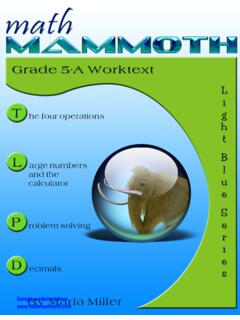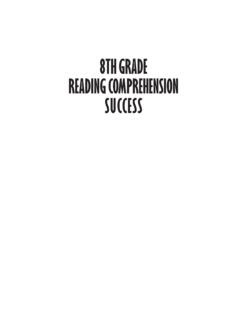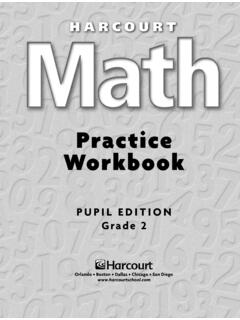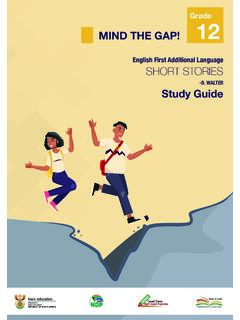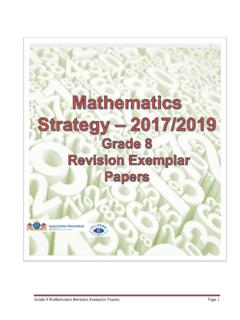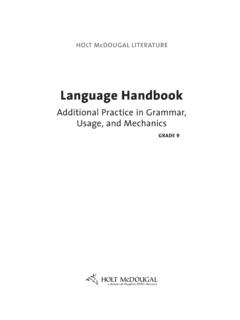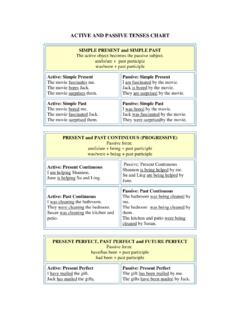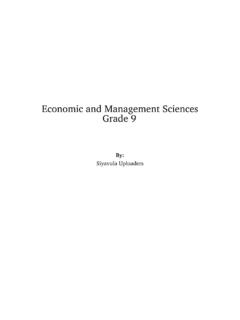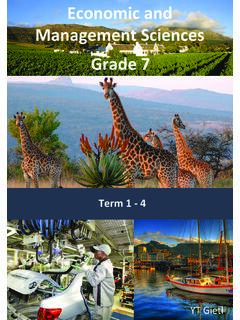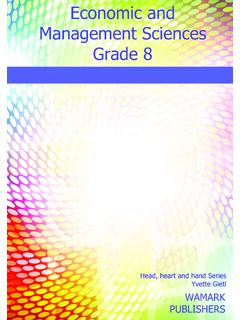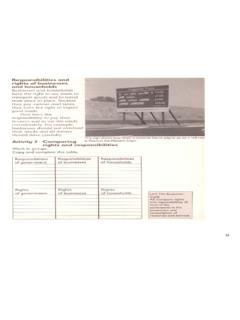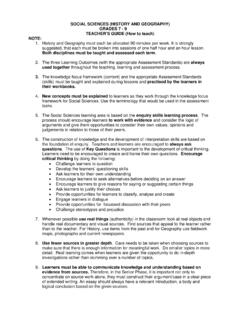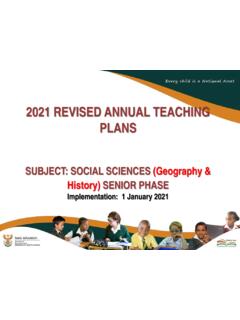Transcription of Economic and Management Sciences Grade 8 - GIFS
1 Economic and Management Sciences Grade 8. By: Siyavula Uploaders Economic and Management Sciences Grade 8. By: Siyavula Uploaders Online: < >. CONNEXIONS. Rice University, Houston, Texas This selection and arrangement of content as a collection is copyrighted by Siyavula Uploaders. It is licensed under the Creative Commons Attribution license ( ). Collection structure revised: September 11, 2009. PDF generated: February 6, 2011. For copyright and attribution information for the modules contained in this collection, see p. 67. Table of Contents 1 Term 1. The historical development of money .. 1. Trade and the Economic problem .. 6. Economic systems .. 9. Trade Unions .. 15. In ation .. 17. 2 Term 2. Run-up to the reconstruction and development programme .. 21. The national budget, growth and economical equalities .. 25. Savings and investment .. 27. Employing technology.
2 30. 3 Term 3. Assets, liabilities and ownership interest .. 33. Leadership and business strategies .. 37. Methods of saving and calculating returns .. 41. Depositslip as a source document .. 44. The net value of the business and the accounting equation .. 49. 4 Term 4. What is an entrepreneur? .. 55. What are the origins of a business venture? .. 58. How feasible is my business? .. 60. How do I nance my business? .. 63. Attributions .. 67. iv Chapter 1. Term 1. The historical development of money1. Economic AND Management Sciences . Grade 8. THE Economic CYCLE. Module 1. THE HISTORICAL DEVELOPMENT OF CURRENCY/MONEY. ASSESSMENT STANDARD : THE HISTORICAL DEVELOPMENT OF CURRENCY/MONEY. When you have completed this MODULE, YOU WILL BE ABLE TO DESCRIBE THE HISTORICAL. DEVELOPMENT OF CURRENCY AND THE ROLE THAT IT PLAYS IN SOCIETIES AND THEIR. ECONOMY. The Economic life of nations shows clear phases of development.
3 The rst of these development phases is always represented as the SELF-SUFFICIENT stage. The most characteristic feature of the self-provident phase is SUBSISTENCE ECONOMY, in which each family or person produces enough to provide in their own needs. The individual or family practised PRIMITIVE AGRICULTURE, which produced enough for his/their own needs. The self-provident stage therefore did not need barter, or a medium of exchange, because production did NOT result in ANY SURPLUS. The economy / family had no need for a MEDIUM. OF EXHANGE or CURRENCY / MONEY as we know it. Activity 1. SUBSISTENCE ECONOMY. GROUP: Your group has survived the accident that forced the aeroplane in which you were travelling to crash down on a remote island. Having regained consciousness, you nd that the wreck of the aeroplane was destroyed in an explosion after the disaster. The island is small and has a relatively high rainfall.
4 HOW WILL YOU GO ABOUT TO PROVIDE IN YOUR NEEDS IN ORDER TO ENSURE SUR- VIVAL? (Suggestion: Begin by determining what your immediate needs are). (Submit a brief list.). GROUPS: Try to identify the characteristic features of an Economic situation in which you have to be self-su cient. 1 This content is available online at < >. 1. 2 CHAPTER 1. TERM 1. During the next phase of Economic development, which is characterised by SPECIALISATION, SUR- PLUSES AND EXCHANGE, communities/families produced su cient products to have surpluses that they could exchange for other products that they needed. EXAMPLE: John, being skilled in making garments from animal pelts, was able to concentrate on doing that ( he SPECIALISED in the production of clothing) and could use the extra garments that he did not need himself (SURPLUS) to engage in EXCHANGE for Peter's SURPLUS of our and related wheat products.
5 This is how the rst MARKETS, where BUYERS and SELLERS met and exchanged their SURPLUSES, came into being. Activity 2. SPECIALISATION. SELF: Design and build a model of a house, using sti paper or cardboard, according to your own ideas. Activity 3. SPECIALISATION AND DIVISION OF LABOUR. GROUP: Design and build a model of a house, using sti paper or cardboard, according to your own ideas. For this exercise, the planning and building of di erent component parts of the house must be delegated to di erent members of the group. One might be responsible for the roof, another for the walls, a third for the general framework, etc. (Note: The di erent parts will have to be tted together to form a whole.). GROUP: Compile a list of advantages and disadvantages of specialisation as encountered in this group work exercise. ADVANTAGES OF SPECIALISATION DISADVANTAGES OF SPECIALISATION.
6 1. 1. 2. 2. 3. 3. 4. 4. Table The following shortcomings had to be reckoned with to allow for TRADE BY EX- CHANGE/BARTERING: It was necessary to nd someone with a congruent need before exchange could take place;. su cient products had to be available for exchange;. the products needed to be able to be divided;. products needed to be transportable; and a standard unit for expressing the value of products was needed. These problems associated with such barter (exchange trade) made people search for a medium that would be acceptable to all in exchange for their products. Anything that was in common usage and accepted by all would be acceptable as a MEDIUM OF EXCHANGE. The search for a MEDIUM OF EXCHANGE makes it possible to identify the stages of development. The rst phase: One product was exchanged for another, without the use of currency , or a third product , one bag of wheat was exchanged for one set of clothes.
7 This therefore was the exchange rate that became the norm: 3. 1 set of clothing = 1 bag of wheat The second phase: During this phase, a third thing in which the value of goods could be expressed was introduced. Such a third thing/article normally comprised a product that was regarded as valuable in particular communities, a sheep, which was signi cant of a person's wealth. Barter (exchange transactions) could therefore be entered into in relation to the value of a sheep or a number of sheep, : 2 sets of clothing = 1 sheep = 2 bags of wheat The third phase: During this phase, an exchange medium that remained generally acceptable but overcame the short- comings mentioned above became necessary. Metals like copper, silver and gold, which were regarded as precious , proved to be particularly suitable for use in this regard and for acceptance as medium of exchange.
8 In terms of our example, we would present this as follows: 1 set of clothing = 1 oz of silver = 1 bag of wheat The fourth phase: Because of the danger linked to carrying large amounts of precious metals on long journeys undertaken to trade in distant parts, it became customary to deposit the metals with approved goldsmiths and obtain a receipt acknowledging the deposit (the gold certi cate). It then became acceptable to merely submit the certi cates as proof in exchange transactions. The next step had goldsmiths issuing certi cates in di erent denominations, which also became an acceptable medium of exchange. The fth phase: When goldsmiths realised that the gold and silver for the certi cates were not claimed that frequently, they began issuing more gold certi cates (paper money) than could be substantiated with gold from their co ers. This was the origin of modern paper money.
9 The sixth phase: The most recent developments, besides printing of notes and minting of coins, involve the use of cheques and credit facilities. An amount is paid into a current account at a bank and the account holder can then write out a cheque to present as payment. The recipient of the cheque can deposit the money (cheque amount) into his or her own account or withdraw it as cash. In this way a cheque performs all the functions of currency. The historical development of currency can be set out to show four speci c phases: THE DEVELOPMENT OF GOODS CURRENCY, when primitive communities had no need for money because of the self-provident nature of their existence. THE DEVELOPMENT OF METAL CURRENCY (COINS), which was easier to handle, more easily recognisable and of more constant value and therefore improved barter (trading by exchange.). THE DEVELOPMENT OF PAPER CURRENCY because metal was too expensive, cumbersome and involved too much risk to be used as the only means of payment.
10 THE DEVELOPMENT OF CHEQUES AND CHEQUE DEPOSITS, which is the current basis of trade and exchange transactions in the present-day economy. This development of currency or money continues and the modern trend is towards a cashless society in which all forms of credit card and electronic transfers are used for local as well as foreign payments. Activity 4. DEVELOPMENT OF CURRENCY/MONEY. SELF: Compile a list of all kinds of money and money associated instruments that are in use in South Africa. 4 CHAPTER 1. TERM 1. Activity 5. DEVELOPMENT OF CURRENCY/MONEY. GROUP: Divide the money that was identi ed by the group into the following categories: MONEY MONEY ASSOCIATED INSTRUMENTS. Table Activity 6. FUNCTIONS OF MONEY IN THE ECONOMY. GROUP: Refer to the above to deduce the functions of money within the economy. Activity 7. THE ROLE OF CREDIT CARDS. GROUP: Compile a list of all the credit cards of which you have heard: [LO ].
